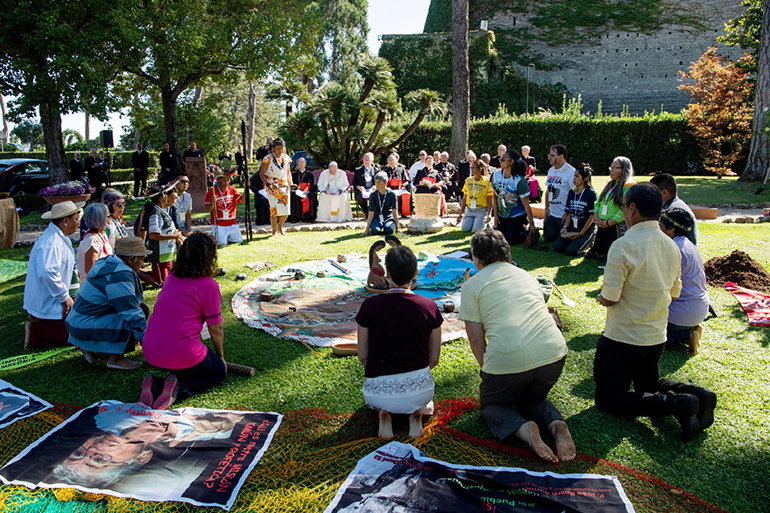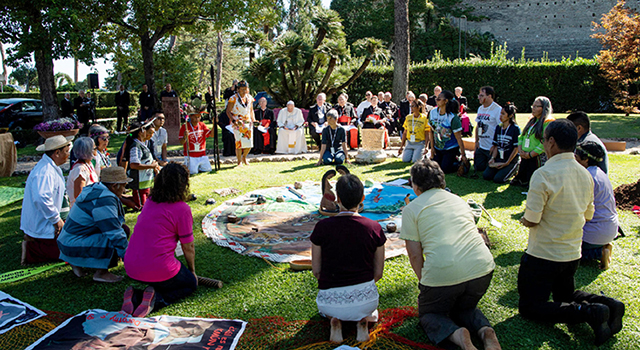By La Voz Catolica staff - La Voz Catolica

Photographer: Vatican Media/CNA
Pope Francis attends a tree planting ceremony inside the Vatican gardens on the feast of St. Francis of Assisi, Oct. 4, 2019.
Statuettes representing a pregnant woman and the child she is carrying were presented during the Synod on Amazonia, sparking accusations of idolatry. Five statuettes were thrown into the Tiber. Made of wood, they floated, and the Italian police recovered three of them. Then, at the request of Cardinal Fernando Filoni, prefect of the Congregation for the Evangelization of Peoples, they were entrusted to that Dicastery.
Bishop Felipe Arizmendi Esquivel, emeritus of San Cristobal de las Casas, Chiapas, Mexico, answers the idolatry question from his own experience among indigenous populations, and as one who is baptized.
This article was published by Zenit on Nov. 8, 2019; and republished in Spanish in the December 2019 edition of La Voz Católica.
SEE
Images and figurines, which were used in the opening ceremonies, in the Vatican Gardens, of the Pan-Amazonian Synod, and in the initial procession from St. Peter’s Basilica to the Synodal Hall, in which Pope Francis took part, and then
THINK
The Bible says: “Then the Lord God formed man of dust from the ground” (Genesis 2:7). On Ash Wednesday we are reminded: “Remember that you are dust and unto dust thou shalt return.” This is the reality of all humans.
In the Document of Aparecida, we give the name “mother” to Sister Earth, following the example of St. Francis of Assisi, who wasn’t an idolater. “With the native people of America, we praise the Lord who created the universe as a space for life and the coexistence of all His sons and daughters and He left it to us as a sign of His goodness and His beauty. Creation is also a manifestation of God’s provident love: it has been given to us to look after it and to transform it into a fitting source of life for all. Although today a greater valuation of nature is generalized, we perceive clearly in how many ways man threatens and destroys his ‘habitat.’ “Our Sister Mother Earth” (Canticle of Creatures, 9) is our common home and that place of God’s covenant with human beings and with the whole of creation. To disregard mutual relations and the balance that God Himself established among created realities, is an offense to the Creator, an attempt against biodiversity and, definitely, against life. The missionary disciple, to whom God entrusted creation, must contemplate it, look after it and use it always respecting the order God gave it” (DA 125).
And to remove all doubt about the pope’s attitude, suffice it to recall what he wrote in Laudato Si’:
“When we become aware of God’s reflection in all that exists, our heart feels the desire to adore the Lord for all His creatures and, together with them, as expressed in St. Francis of Assisi’s beautiful hymn: ‘Be praised, my Lord, with all your creatures . . . ‘”(No. 87).
“The creatures of this world cannot be considered a good without an owner: Thou sparest all things, for they are thine, O Lord who lovest the living” (Wisdom 11:26).
“This arouses the conviction that being created by the same Father, all beings of the universe are united by invisible ties and we make up a sort of universal family, a sublime communion that moves us to sacred, affectionate and humble respect” (No. 89).
“This doesn’t mean making all living beings equal and taking away from the human being that peculiar value that implies at the same time a tremendous responsibility. Neither does it imply a divinization of the earth, which would deprive us of the call to collaborate with it and to protect its fragility” (No. 90).
ACT
As Jesus says, let us not judge as idolatry what is not so. Let us know in greater depth the native cultures. And it’s our task to share Jesus’ Gospel, which frees us from idolatries, wherever they might be.


Comments from readers